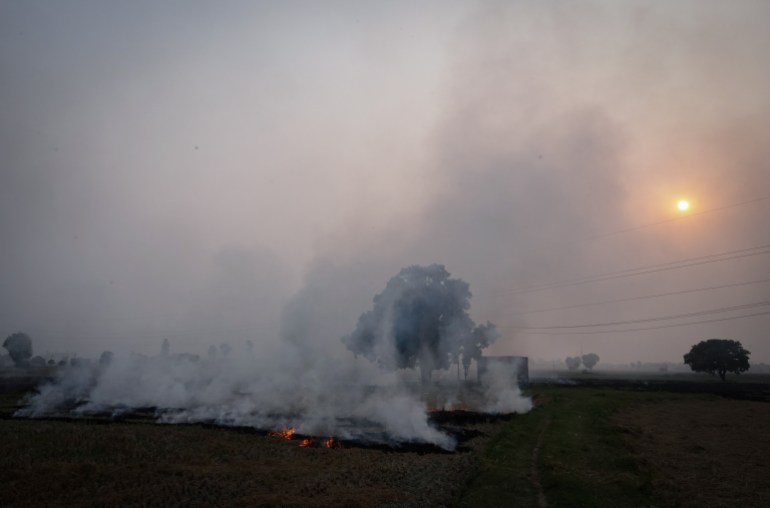Islamabad, Pakistan – Relations between nuclear-armed neighbours Pakistan and India have largely remained tense and stagnant for years. Now, an unlikely catalyst is promising to facilitate dialogue between them: deadly smog that is enveloping key cities in both countries.
A senior government official from Punjab, Pakistan’s most populous province, which borders Indian Punjab, revealed that Chief Minister Maryam Nawaz has shown an interest in visiting her Indian counterpart to address the pressing issue of air pollution. Both Lahore and India’s capital New Delhi have recently ranked among the world’s most polluted cities.
“Chief Minister Maryam Nawaz will be sending a letter to Indian Punjab’s Chief Minister [Bhagwant Singh Mann] in the coming days. She has expressed her willingness to visit India and extend an invitation for him to visit Pakistan,” Raja Jahangir Anwar, Punjab’s secretary for environment and climate change, told Al Jazeera.
Anwar added that, given the adverse climatic conditions affecting the region, Pakistan is also considering hosting a regional climate conference in Lahore before the year ends.
“We recognise that these matters fall under external affairs, requiring approval from the federal government and relevant stakeholders, but this situation is urgent,” he emphasised. “If this can bring Pakistan and India together, along with other countries, why waste this opportunity?”
Since September, falling temperatures, changing atmospheric conditions and domestic emissions have severely affected Lahore and New Delhi, with air quality indices (AQI) frequently surpassing 300 micrograms of PM2.5 – fine particulate matter measuring 2.5 microns or smaller. That is far above the limit of 100 micrograms of PM2.5 that is considered acceptable.
The PM2.5 particles are released from both human activities and natural events and pose serious health risks, as they can penetrate deep into human respiratory systems.
With the ever-increasing air pollution levels, Nawaz, daughter of three-time former Prime Minister Nawaz Sharif and a proponent of normalising relations with India, has in recent days reiterated her commitment to pursuing “climate diplomacy”.
Speaking at a Diwali event in Lahore on Wednesday, she emphasised the need for both nations to collaborate on this issue.
“This matter has to be resolved diplomatically with India. I am considering writing a letter to Indian Punjab’s chief minister. This is not a political issue, it is a humanitarian one,” she said.
Nawaz further added that while her government is taking steps to address the crisis, reciprocal action from India is essential.
“Winds don’t know there is a line [border] in between. This has to be done for the betterment for Indian people and their wellbeing, as well as for Pakistan’s people too,” the chief minister said.
The plea for collaborating with India comes as Lahore has seen the presence of PM2.5 exceed even 700 micrograms in recent days. The government has announced imposing a “green lockdown” in Lahore, a city of 15 million people, banning various commercial and construction activities.

During the early hours of November 1, according to live data monitored and compiled by IQAir, a Swiss climate group, New Delhi was the most polluted city in the world with 585 micrograms of PM2.5 in its atmosphere, closely followed by Lahore, which recorded 240 micrograms of PM2.5.
Muhammad Farooq Alam, a deputy director at Pakistan Punjab’s Environmental Protection Agency, explained that the worsening air quality during autumn and winter results from various factors. Cold air is heavier than warmed air and sinks close to the surface of the Earth, along with the particles it carries.
“As temperatures decrease after September, emissions from both human activities and natural events become concentrated within a dispersion area of one to two kilometres in the atmosphere, compared to over 12 to 15 kilometres during the summer,” he told Al Jazeera. “It feels like living and breathing in a small, locked room with no ventilation.”
Alam said sources of the pollution included industrial emissions, vehicular traffic, residential and commercial outputs – and stubble burning, a controversial practice in which farmers burn the remnants of existing crops to clear the ground in order to sow a new crop for the upcoming season.
Last year, during the smog season, farmers in both countries were criticised for burning crop stubble, exacerbating air pollution.
“Among various mitigation strategies, we have discussed controlling vehicular traffic, but the financial costs, which could reach billions, pose a significant challenge. The magnitude of the problem is enormous,” he said.
Anwar, the provincial secretary, urged a shift away from blaming individual countries and called for raising awareness about the weather phenomena contributing to this issue.
He added that while agricultural practices are similar in both countries, India’s larger size results in a higher volume of crop stubble burning.
“Weather patterns indicate the onset of an eastern wind corridor, which will carry pollutants toward Pakistan, likely causing Lahore’s AQI to rise again by Sunday or Monday,” he said.

Dawar Hameed Butt, co-director of the Pakistan Air Quality Initiative (PAQI), a climate research and advocacy group, said that the chief minister’s suggestion to engage with her Indian counterpart necessitates a transboundary pollution management approach.
“The Male Declaration among South Asian countries aimed to develop such an approach but was unsuccessful. Recent efforts to revive it are under way, but the specifics remain uncertain,” he explained.
The Male Declaration, signed in 1998, is the only existing intergovernmental framework in South Asia addressing air pollution and includes Bangladesh, Bhutan, India, Iran, the Maldives, Nepal, Pakistan and Sri Lanka.
According to an IQAir report released in April 2023, South Asia remains the most severely affected region in the world for air pollution.
While the World Health Organization (WHO) recommends that average annual PM2.5 levels should not exceed five micrograms per cubic metre, last year saw Bangladesh, Pakistan and India among the countries with the worst air quality indices.
Bangladesh recorded an alarming 79.9 micrograms, nearly 16 times higher than the WHO recommendation, while Pakistan scored 73.7 and India recorded 54.4 micrograms.
The Lancet, the United Kingdom-based medical journal, in a recent report estimated that 1.6 million people in India died in 2021 due to air pollution.
Butt asserts that ultimately, the solutions are clear – even if not necessarily easy to implement for developing countries. “Both sides must transition to cleaner energy sources across all sectors and implement effective management of crop waste, which requires significant investment and a major shift in public behaviour,” he said.





